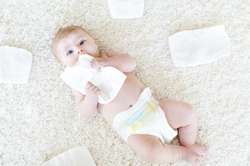All over the world, mothers of newborns are very sensitized to the ingredients being used in anything they use with their babies, whether it’s the food and formula they consume, the soaps and lotions they use to keep their babies clean and soft, or other baby products like diapers and wipes.
Skin Health and Environmental Concerns Related to Disposables
Today, many mothers around the world are becoming especially aware of the diapers they use and the fabrics that come in contact with the baby. Diaper rash is and has been an ongoing issue for many, many years. According to the Mayo Clinic, diaper rash affects about 35 percent of American children under the age of 2. The most common cause of diaper rash is the infrequency of diaper changes that allows bacteria in feces or yeast that thrive in warm, moist environments to infect the baby’s skin.
Johnson & Johnson introduced the first mass-marketed disposable diaper in 1948, while Pampers emerged in the market in 1961. Until these innovations, most mothers used washable/reusable diapers made from cotton. By 1980, babies in the United States wore 1.93 million tons of disposables, representing 1.4 percent of all municipal landfill waste. By 1990, that number had increased to 1.6 percent, eclipsing 2 percent by the year 2000. Adding to the waste problem was the fact that these early-generation disposables were made of plastics and synthetic fibers that can take more than 50 years to biodegrade.
So, with modern, disposable diapers, we have a pair of problems to solve: do they promote healthier skin for babies, and do they promote a healthier planet?
Healthier Skin for Baby? Cotton Is the Answer
In reaction to the first question, consumers globally are demanding more natural products for their babies’ skin. Purified cotton, for example, has a long history of safety and breathability next to the skin. Most adults wear cotton underwear for exactly the same reason, so using diapers made with purified cotton makes a lot of sense. Skin health is so important to a baby’s well-being, and the softness of cotton is the perfect match for a baby’s soft skin.
While we’re on the topic of skin health for babies, let’s not forget the wipes! Most mothers don’t realize that their wipes are made from synthetic fibers. In fact, the wipe fabric is really only the chassis for the lotion to clean the baby’s bottom in most cases. You also have to take account of what’s in the lotion, and whether the ingredients are healthy for babies.
Thankfully, there are new innovations available in baby wipes, too. These new products are integrating cotton into the wipe with natural solutions, which allow the fabric to do most of the cleaning, rather than simply rubbing lotion on the baby’s skin. Purified cotton has proven to be highly absorbent in the context of wipes and highly effective in taking care of the task of cleaning, too. It’s the same dynamic we’ve seen from cotton when we use this fabric in our washcloths and towels.
Cotton Means a Healthier Planet, Too
So, what about that landfill problem? The average baby works through nearly 5,000 diapers before potty training. Given the large and growing number of disposable products that are used globally, doesn’t it just make sense to use natural fibers such as cotton in our baby products? Purified Cotton has been proven to biodegrade in 30 days or less in managed landfills. In contrast, if the industry keeps using synthetic fibers and plastics, that giant pile of diapers will still be there for the next generation to worry about. 30 days is some improvement over 50-plus years!
In conclusion, consumers want the best for their babies and have a preference for natural fibers such as cotton. Cotton has been proven to be safe and comfortable for babies while providing a boon to our global environment by biodegrading in a short period of time.
